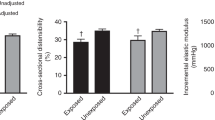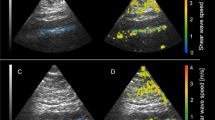Abstract
One of the major complications of arsenic on human health is hypertension. Arsenic-related hypertension and negative effects of arsenic on arterial system such as oxidative stress and vasoconstriction/vasorelaxation imbalance may lead to impair aortic elasticity. The aim of this study was to evaluate the effects of arsenic on aortic elasticity parameters including aortic strain and distensibility. One hundred twelve (112) workers were occupationally exposed to arsenic and 60 healthy control subjects were enroled. All patients underwent transthoracic echocardiography for detecting aortic strain and aortic distensibility. There were no differences in baseline demographic and echocardiographic characteristics between the groups. Aortic strain (10.3±3.9 vs 12.1±2.7%, P=0.001) and aortic distensibility (0.45±0.17 vs 0.54±0.15 cm2 per dyn, P=0.001) were decreased in arsenic-exposure group compared with controls. Urinary arsenic level was found to be negatively and significantly correlated with aortic strain (r=−0.306, P=0.001) and aortic distensibility (r=−0.259, P=0.006). Duration of arsenic exposure was also found to be negatively and significantly correlated with aortic strain (r=−0.386, P<0.001) and aortic distensibility (r=−0.333, P<0.001). This study suggests that arsenic exposure is related to impairment of aortic elasticity parameters even in subjects without overt cardiovascular disease.
This is a preview of subscription content, access via your institution
Access options
Subscribe to this journal
Receive 12 digital issues and online access to articles
$119.00 per year
only $9.92 per issue
Buy this article
- Purchase on Springer Link
- Instant access to full article PDF
Prices may be subject to local taxes which are calculated during checkout



Similar content being viewed by others
References
Chen CJ, Wu MM, Lee SS, Wang JD, Cheng SH, Wu HY . Atherogenicity and carcinogenicity of high-arsenic artesian well water. Multiple risk factors and related malignant neoplasms of blackfoot disease. Arteriosclerosis 1988; 8: 452–460.
Chen CJ, Chiou HY, Chiang MH, Lin LJ, Tai TY . Dose-response relationship between ischemic heart disease mortality and long-term arsenic exposure. Arteriosclerosis, thrombosis, and vascular biology 1996; 16: 504–510.
Wang CH, Jeng JS, Yip PK, Chen CL, Hsu LI, Hsueh YM et al. Biological gradient between long-term arsenic exposure and carotid atherosclerosis. Circulation 2002; 105: 1804–1809.
Tseng WP . Blackfoot disease in Taiwan: A 30-year follow-up study. Angiology 1989; 40: 547–558.
Chiou HY, Huang WI, Su CL, Chang SF, Hsu YH, Chen CJ . Dose-response relationship between prevalence of cerebrovascular disease and ingested inorganic arsenic. Stroke 1997; 28: 1717–1723.
Islam MR, Khan I, Attia J, Hassan SM, McEvoy M, D'Este C et al. Association between hypertension and chronic arsenic exposure in drinking water: a cross-sectional study in Bangladesh. Int J Environ Res Public Health 2012; 9: 4522–4536.
Rahman M, Tondel M, Ahmad SA, Chowdhury IA, Faruquee MH, Axelson O . Hypertension and arsenic exposure in Bangladesh. Hypertension 1999; 33: 74–78.
Yang HT, Chou HJ, Han BC, Huang SY . Lifelong inorganic arsenic compounds consumption affected blood pressure in rats. Food Chem Toxicol 2007; 45: 2479–2487.
Srivastava S, Vladykovskaya EN, Haberzettl P, Sithu SD, D'Souza SE, States JC . Arsenic exacerbates atherosclerotic lesion formation and inflammation in apoe-/- mice. Toxicol Appl Pharmacol 2009; 241: 90–100.
Edwards DH, Li Y, Ellinsworth DC, Griffith TM . The effect of inorganic arsenic on endothelium-dependent relaxation: Role of nadph oxidase and hydrogen peroxide. Toxicology 2013; 306: 50–58.
Hossain E, Ota A, Takahashi M, Karnan S, Damdindorj L, Konishi Y et al. Arsenic upregulates the expression of angiotensin ii type i receptor in mouse aortic endothelial cells. Toxicol Lett 2013; 220: 70–75.
Waghe P, Sarath TS, Gupta P, Kandasamy K, Choudhury S, Kutty HS et al. Arsenic causes aortic dysfunction and systemic hypertension in rats: Augmentation of angiotensin ii signaling. Chem Biol Interact 2015; 237: 104–114.
Lee MY, Jung BI, Chung SM, Bae ON, Lee JY, Park JD et al. Arsenic-induced dysfunction in relaxation of blood vessels. Environ Health Perspect 2003; 111: 513–517.
Redheuil A, Wu CO, Kachenoura N, Ohyama Y, Yan RT, Bertoni AG et al. Proximal aortic distensibility is an independent predictor of all-cause mortality and incident cv events: The mesa study. J Am Coll Cardiol 2014; 64: 2619–2629.
Laurent S, Boutouyrie P, Asmar R, Gautier I, Laloux B, Guize L et al. Aortic stiffness is an independent predictor of all-cause and cardiovascular mortality in hypertensive patients. Hypertension 2001; 37: 1236–1241.
Lang RM, Bierig M, Devereux RB, Flachskampf FA, Foster E, Pellikka PA et al. Chamber Quantification Writing G, American Society of Echocardiography's G, Standards C, European Association of E: Recommendations for chamber quantification: A report from the american society of echocardiography's guidelines and standards committee and the chamber quantification writing group, developed in conjunction with the european association of echocardiography, a branch of the european society of cardiology. J Am Soc Echocardiogr 2005; 18: 1440–1463.
Stefanadis C, Stratos C, Vlachopoulos C, Marakas S, Boudoulas H, Kallikazaros I et al. Pressure-diameter relation of the human aorta. A new method of determination by the application of a special ultrasonic dimension catheter. Circulation 1995; 92: 2210–2219.
Stefanadis C, Stratos C, Boudoulas H, Vlachopoulos C, Kallikazaros I, Toutouzas P . Distensibility of the ascending aorta in coronary artery disease and changes after nifedipine administration. Chest 1994; 105: 1017–1023.
Chen CJ, Hsueh YM, Lai MS, Shyu MP, Chen SY, Wu MM et al. Increased prevalence of hypertension and long-term arsenic exposure. Hypertension 1995; 25: 53–60.
Jensen GE, Hansen ML . Occupational arsenic exposure and glycosylated haemoglobin. Analyst 1998; 123: 77–80.
Simeonova PP . Luster MI: Arsenic and atherosclerosis. Toxicol Appl Pharmacol 2004; 198: 444–449.
Qian Y, Liu KJ, Chen Y, Flynn DC, Castranova V, Shi X . Cdc42 regulates arsenic-induced nadph oxidase activation and cell migration through actin filament reorganization. J Biol Chem 2005; 280: 3875–3884.
Wang F, Liu S, Xi S, Yan L, Wang H, Song Y et al. Arsenic induces the expressions of angiogenesis-related factors through pi3k and mapk pathways in sv-huc-1 human uroepithelial cells. Toxicol Lett 2013; 222: 303–311.
Barchowsky A, Klei LR, Dudek EJ, Swartz HM, James PE . Stimulation of reactive oxygen, but not reactive nitrogen species, in vascular endothelial cells exposed to low levels of arsenite. Free Radic Biol Med 1999; 27: 1405–1412.
Lassegue B, Sorescu D, Szocs K, Yin Q, Akers M, Zhang Y et al. Novel gp91(phox) homologues in vascular smooth muscle cells: Nox1 mediates angiotensin ii-induced superoxide formation and redox-sensitive signaling pathways. Circ Res 2001; 88: 888–894.
Cruickshank K, Riste L, Anderson SG, Wright JS, Dunn G, Gosling RG . Aortic pulse-wave velocity and its relationship to mortality in diabetes and glucose intolerance: an integrated index of vascular function? Circulation 2002; 106: 2085–2090.
Siegel E, Thai WE, Techasith T, Major G, Szymonifka J, Tawakol A et al. Aortic distensibility and its relationship to coronary and thoracic atherosclerosis plaque and morphology by mdct: Insights from the romicat trial. Int J Cardiol 2013; 167: 1616–1621.
Nabi AH, Rahman MM, Islam LN . Evaluation of biochemical changes in chronic arsenic poisoning among Bangladeshi patients. Int J Environ Res Public Health 2005; 2: 385–393.
Bae HS, Ryu DY, Choi BS, Park JD . Urinary arsenic concentrations and their associated factors in korean adults. Toxicol Res 2013; 29: 137–142.
Mendez MA, Gonzalez-Horta C, Sanchez-Ramirez B, Ballinas-Casarrubias L, Hernandez Ceron R, Viniegra Morales D et al. Chronic exposure to arsenic and markers of cardiometabolic risk-a cross-sectional study in chihuahua, mexico. Environ Health Perspect 2016; 124: 104–111.
Acknowledgements
There are no sources of support including sponsorship or sources of material not available commercially.
Author information
Authors and Affiliations
Corresponding author
Ethics declarations
Competing interests
The authors declare no conflict of interest.
Rights and permissions
About this article
Cite this article
Karakulak, U., Yilmaz, O., Tutkun, E. et al. Evaluation of aortic elasticity parameters in arsenic exposed workers. J Hum Hypertens 30, 709–713 (2016). https://doi.org/10.1038/jhh.2015.128
Received:
Revised:
Accepted:
Published:
Issue Date:
DOI: https://doi.org/10.1038/jhh.2015.128
This article is cited by
-
Associations of coal mine dust exposure with arterial stiffness and atherosclerotic cardiovascular disease risk in chinese coal miners
International Archives of Occupational and Environmental Health (2024)



